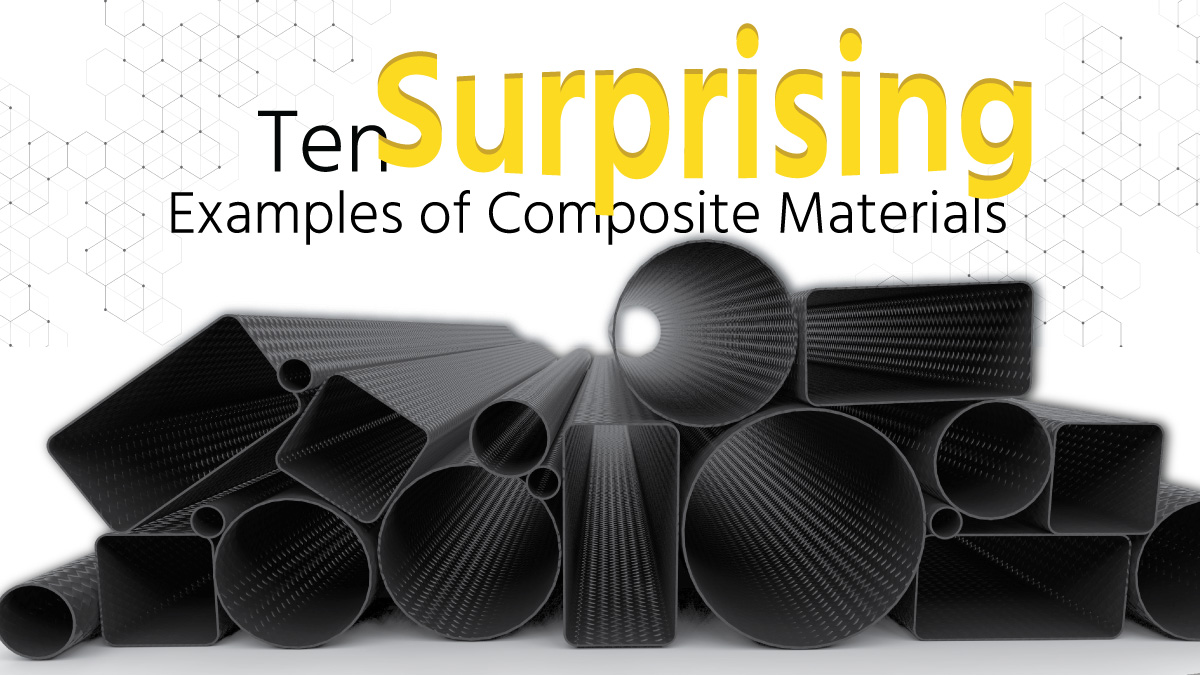10 Surprising Examples of Composite Materials
Chances are they’re in your flooring, your walls, your car, and even your bathtub. They’re called composites.
But what exactly are composites? What are their uses and why do they matter?
If you’ve got these questions looming your mind or if you’d like some surprising examples of composite materials, then you’ve come to the right place.
Read on to learn about composite materials and the 10 most surprising examples of composite materials.
Examples of Composite Materials
A composite is a material that is made by combining two or more substances that have different physical properties. An ideal composite is made of materials that complete each other’s shortcomings. For example, a material that compresses well could be combined with a material that stretches well to form a compressible and stretchable composite.
The promise of a “no-compromises” material that accomplishes exactly what you want sounds like a fantasy. Yet, composite materials manage to do just that.
1. Mud Bricks
What better way to introduce composites than to talk about mud bricks. Mud bricks came to be when people realized that straw was resistant to stretching and that dried mud copes well with compression.
The ancient Egyptians used a composite of clay mixed with straw. Developing countries use mud bricks to build their huts. Perhaps the introduction of the mud-brick is what inspired much more advanced composites, as we’ll see later on.
2. Wood
Wood (and trees, of course) have been around for thousands of years. Yet, you might be surprised to find out that wood is actually a composite. Wood is made of long fibers of cellulose that are held together by a weaker substance called lignin.
The organization of the cellulose within the wood is what makes some types of wood (like ironwood) stronger than others. Engineered wood, such as plywood, takes advantage of weaker woods by cutting them into thin pieces and then gluing them together. This gives plywood the flexibility and the softer qualities that allow for nailing into plywood.
3. Fiberglass
Fiberglass is simply plastic that is combined with glass fibers. It is likely that your bathtubs, doors, decking, and window frames all take advantage of fiberglass is some way.
Fiberglass is particularly useful in windows since the fiberglass and glass windowpane shares an almost identical coefficient of expansion, meaning that hot and cold temperatures let your entire window expand and contract as one piece.
4. Translucent Concrete
Concrete is a primitive example of composite material because of the combination of small rocks and cement that it holds. When optic fibers, similar to those found in fiberglass, are added to concrete, you get translucent concrete. The look and feel of the concrete can vary depending on the ratio of cement to optic fibers.
5. Absorbent Concrete
Videos of this concrete have been circulating around the internet for a while. Absorbent concrete may seem like something straight out of a comic book but while it does seem impossible, there’s actually a decent bit of science to back it up.
Absorbent concrete works by allowing water (and other viscous liquids) to seep through large pebbles and into another layer of rubble. This type of concrete can prove to be useful in dealing with flooding once implemented on a large scale.
6. Kevlar
While Kevlar is not a composite in itself, it is often used as a part of composite materials. This is because of Kevlar’s extremely high tensile strength, meaning that it can resist stretching quite well. Kevlar’s compressive strength is about 1/10 of its tensile strength, and that’s why it is combined into composites.
Airplanes, boats, bicycles, motorcycle clothing, and Nike shoes all take advantage of Kevlar’s remarkably high tensile strength.
7. Carbon Fiber
Carbon fiber is often combined with plastics into what is called carbon fiber reinforced polymer. These compounds are used in airplane wings, automobile body parts, and sports equipment.
Benefits of carbon fiber include, but are not limited to, high stiffness and strength, lightness, corrosion resistance, and a low coefficient of thermal expansion (meaning that it doesn’t expand or contract very well).
8. Pykrete
Ice and wood are adequately strong in their own ways but when combined together, they form a composite called Pykrete. Pykrete (also known as bulletproof ice) is a combination of ice and wood pulp that can be up to 14 times stronger than ice.
9. Composite Honeycomb
This is a broad category of composites that all share the same characteristic of a honeycomb design. Man-made composite honeycomb is useful because of its high compressive and shear strength. Honeycomb designs can make products cheaper since less material is required to achieve the same desired strength.
10. Engineered Bamboo
Plywood, bamboo strips, and glue can be combined to create engineered bamboo flooring. Bamboo’s high tensile strength, hardness, and lightweight nature make it desirable when combined into a composite flooring material.
In fact, temporary bamboo huts were constructed for victims of the 2004 Indian Ocean tsunami. This just comes to show how useful bamboo can be in lightweight construction applications.
There’s More!
Hundreds, if not thousands, of examples of composite materials, exist in today’s world. Applications in the medical, aerospace, automotive, and military fields exist in abundance.
If you’re looking for composite materials, then make sure to check us out. We provide composites for a variety of industries including automotive, aerospace, defense, medical, and sports/recreation.
For more information on how we may be the right supplier for your needs, then head over to our About page.

